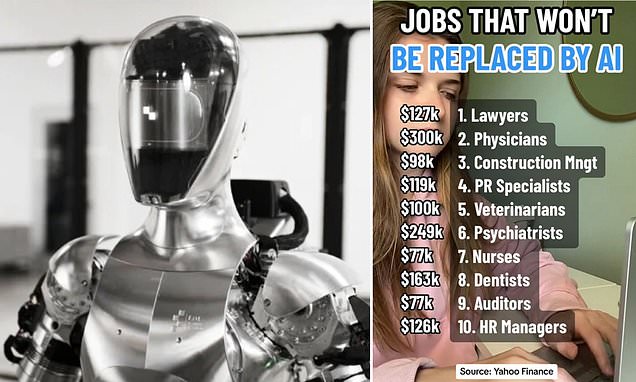According to experts from the Massachusetts Institute of Technology (MIT), there is a silver lining for human workers—they are comparatively inexpensive.
The researchers at MIT have observed that the impact of AI on the job market has been slower and more expensive than initially anticipated by many early adopters.
Their analysis revealed that AI automation is only justifiable for approximately 23 percent of businesses.
‘In numerous instances, humans present a more cost-effective solution,’ stated Neil Thompson, a contributor to MIT’s extensive 45-page report.
From an executive standpoint, they are currently ‘a more economically viable option for carrying out tasks,’ as stated to CNN by Thompson.
Poll
Are you concerned about the evolving job landscape?
- Yes, 873 votes
- No, 667 votes
- Not sure, 128 votes
Feel free to share your perspective.
Concerns have been raised regarding the potential for chatbots and other AI technologies to result in widespread job displacements, as companies opt for machines that are cheaper, quicker, and do not require breaks.
Initially, bank tellers, cashiers, data entry clerks, and secretaries are expected to be the first casualties of this shift.
A study conducted by Goldman Sachs indicated that a quarter of jobs could be automated in the near future.
Furthermore, McKinsey forecasted that half of all tasks could be automated by 2055.
The World Economic Forum (WEF) analysts cautioned that a staggering 83 million jobs could be eliminated globally within the next five years.
They highlighted roles such as bank and postal clerks, cashiers, secretaries, and others that might be displaced by technological advancements.
Simultaneously, the WEF projected the creation of 69 million jobs in emerging sectors like AI, sustainability, and robotics.
However, despite the job creation, there remains a net loss of 14 million jobs, equating to 2 percent of the current global workforce.
Amidst these concerns, apprehensive employees turned to platforms like TikTok to voice their anxieties about potential job obsolescence.
Some individuals compiled a list of professions deemed AI-resistant and advised current students to consider these fields, including lawyers, therapists, and entertainers.
Optimists reassured others not to fret, suggesting that robots could handle mundane tasks, allowing individuals to engage in more enjoyable and creative pursuits.
The recent study by MIT’s Computer Science and Artificial Intelligence department challenges these apprehensions.
The researchers examined the feasibility of automating various tasks using AI and assessed the timeline for potential automation.
They scrutinized 414 jobs that are often perceived as vulnerable to automation, particularly those involving visual responsibilities.
This category includes roles like retail store supervisors who oversee pricing and inventory, as well as nurse anesthesiologists who monitor patient indicators such as pupil dilation and skin color.
Subsequently, they evaluated the remuneration associated with these positions and computed the expenses linked to automation.
In many instances, the researchers concluded that the cost of automating at-risk jobs would not be justifiable in the near future.
For instance, the task of monitoring merchandise and prices in a retail setting could be performed by machines, but the investment required is substantial.
In fact, the cost of automation surpasses the wages of a human store clerk, according to their findings.
Even large corporations with over 5,000 employees would find it economically viable to automate less than ten percent of their current visual tasks.
Thompson emphasized, ‘Although AI shows potential in task replacement, immediate widespread automation is unlikely.’
‘It is crucial to consider the economic implications of implementing such systems,’ he added.






